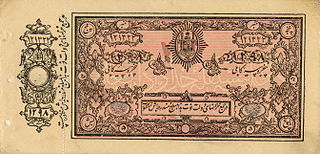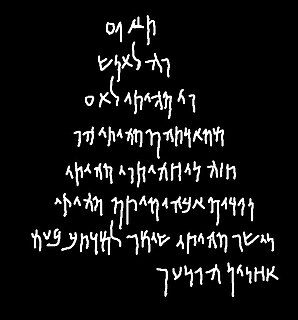
The tenga was the currency of Kokand until 1876. Silver tenga circulated with copper pul and gold tilla. There was no fixed relationship between the three denominations. The Russian ruble replaced the Pul, Tenga and Tilla.

The tenga was the currency of Kokand until 1876. Silver tenga circulated with copper pul and gold tilla. There was no fixed relationship between the three denominations. The Russian ruble replaced the Pul, Tenga and Tilla.

The afghani is the currency of the Islamic Republic of Afghanistan, which is issued by the nation's central bank called Da Afghanistan Bank. It is nominally subdivided into 100 puls (پول), although there are no pul coins currently in circulation. In 2020, one U.S. dollar was exchanged for approximately 77 afghanis.

The soʻm is the currency of Uzbekistan in Central Asia.
The dinar was the currency of Croatia between 23 December 1991 and 30 May 1994. The ISO 4217 code was HRD.
The austral was the currency of Argentina between June 15, 1985, and December 31, 1991. It was subdivided into 100 centavos. The symbol was an uppercase A with an extra horizontal line, code point U+20B3₳AUSTRAL SIGN. This symbol appeared on all coins issued in this currency, to distinguish them from earlier currencies. The ISO 4217 code is ARA.
The Ghanaian pound was the currency of Ghana between 1958 and 1965. It was subdivided into 20 shillings, each of 12 pence. Until 1958, Ghana used the British West African pound, after which it issued its own currency. In 1965, Ghana introduced the first cedi at a rate of 1 pound = 2.4 cedis, i.e., 1 cedi = 100 pence.

The Zambian pound was the currency in Zambia from independence in 1964 until decimalization on January 16, 1968. It was subdivided into 20 shillings, each of 12 pence.

The franc was the currency of Cambodia between 1875 and 1885. It was equal to the French franc and was similarly subdivided into 100 centimes. It circulated alongside the piastre with 1 piastre = 5.37 francs. It replaced the tical and was replaced by the piastre. No paper money was issued.

The Afghan rupee was the currency of Afghanistan until 1925. Before 1891, silver rupees circulated with copper falus and gold mohur. The three metals had no fixed exchange rate between them, with different regions issuing their own coins.
The tenga was the currency of Bukhara until 1920. It was subdivided into 10 falus. It was replaced by the Russian ruble at a rate of 1 ruble = 5 tenga.
The peso ley, usually known as either peso or, to distinguish it from the earlier peso moneda nacional, informally as peso ley, was the currency of Argentina between January 1, 1970, and May 5, 1983. It was subdivided into 100 centavos. Its symbol was $L, sometimes $. Its name comes from law 18188 which established it, effective April 5, 1969. Its ISO 4217 code was ARL.
The dollar was the currency of New Brunswick between 1860 and 1867. It replaced the pound at a rate of 4 dollars = 1 pound and was equal to the Canadian dollar. The New Brunswick dollar was replaced by the Canadian dollar at par when New Brunswick entered the Canadian Confederation.
The dollar was the currency of Nova Scotia between 1860 and 1871. It replaced the Nova Scotian pound at a rate of 5 dollars = 1 pound and was consequently worth less than the Canadian dollar. The Nova Scotian dollar was replaced by the Canadian dollar at a rate of 73 Canadian cents = 75 Nova Scotian cents, thus maintaining the difference between the two currencies established in 1860.

Tenga is a Japanese brand of male masturbation aids by the company of the same name. Masturbation aids (masturbators), personal lubricants, and other related products are sold under this brand. The company's masturbators have been noted for their design aesthetics unexpected for a sex toy, and have received an industrial design award.
Benchen Monastery is the name of two Buddhist temples. The original Benchen Monastery in Tibet was destroyed by the Chinese Army in 1959. It later began to be reconstructed by the surviving sangha in the 1980s. The second Benchen monastery in Kathmandu, Nepal was constructed under the direction of two exiled Tulkus from the original monastery.
The franc was the currency of French Equatorial Africa. The French franc circulated, together with distinct banknotes from 1917 and coins from 1942. It was replaced by the CFA franc in 1945.

The franc was the currency of French West Africa. The French franc circulated, together with distinct banknotes from 1903 and coins from 1944. It was replaced by the CFA franc in 1945.
The Nike PUL 9 is an Argentine experimental tailless aircraft powered by a Rotax 447 engine.
Pul Adasi is a village in Khvosh Rud Rural District, Bandpey-ye Gharbi District, Babol County, Mazandaran Province, Iran. At the 2006 census, its population was 132, in 29 families.
Pūl was a historical Russian currency that circulated in Russian Turkestan. Pūls were used in Golden Horde, Afghanistan, Bukhara, Chagatai Khanate, Kokand Khanate, Dzungar Khanate, and other Eurasian principalities, it was a copper coin of very small denomination, 1/60 of an altyn.

The Pul-i-Darunteh Aramaic inscription, also called Aramaic inscription of Lampaka, is an inscription on a rock in the valley of Laghman, Afghanistan, written in Aramaic by the Indian emperor Ashoka around 260 BCE. It was discovered in 1932 at a place called Pul-i-Darunteh. Since Aramaic was the official language of the Achaemenid Empire, which disappeared in 320 BCE with the conquests of Alexander the Great, it seems that this inscription was addressed directly to the populations of this ancient empire still present in northwestern India, or to border populations for whom Aramaic remained the language of use.
| This article about a unit of currency is a stub. You can help Wikipedia by expanding it. |
| | This Uzbekistan-related article is a stub. You can help Wikipedia by expanding it. |
| | This article related to Central Asian history is a stub. You can help Wikipedia by expanding it. |